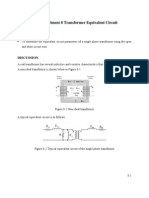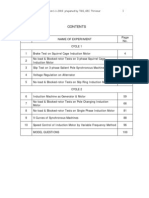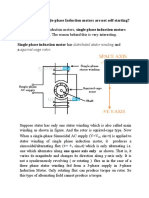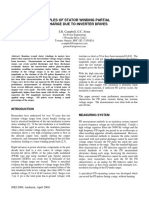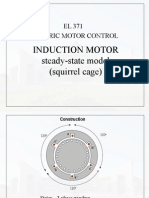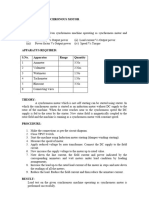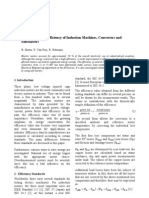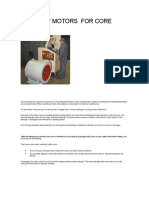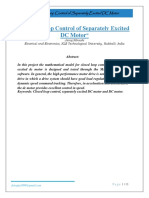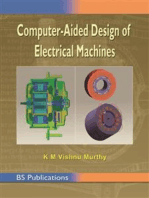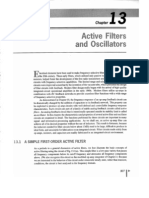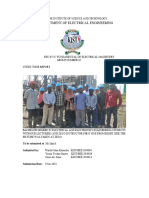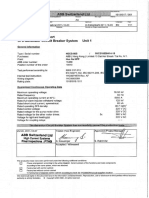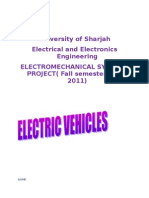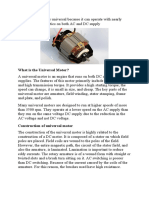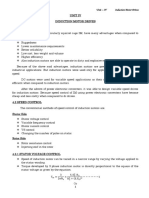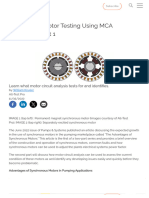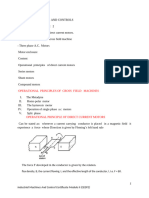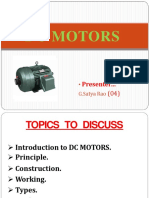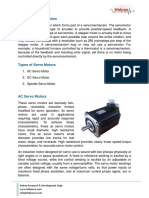AC Machines Lab Manual PDF
AC Machines Lab Manual PDF
Uploaded by
റിജിൽ വി ആർCopyright:
Available Formats
AC Machines Lab Manual PDF
AC Machines Lab Manual PDF
Uploaded by
റിജിൽ വി ആർOriginal Title
Copyright
Available Formats
Share this document
Did you find this document useful?
Is this content inappropriate?
Copyright:
Available Formats
AC Machines Lab Manual PDF
AC Machines Lab Manual PDF
Uploaded by
റിജിൽ വി ആർCopyright:
Available Formats
A.C.
Electrical Machines Lab
Department of Electrical and Electronics
Engineering
Electrical Machine-II
Laboratory Manual
Gokaraju Rangaraju Institute of Engineering & Technology
BACHUPALLY, MIYAPUR, HYDERABAD-500090
GRIET/E.E.E.
A.C. Electrical Machines Lab
Department of Electrical and Electronics
Engineering
CERTIFICATE
This is to certify that this book is a
bonafide record pratical work done in the
Electrical
Machines-11
Laboratory
in ........semester ofyear during the
year.......
Name :-..
Roll.No :-
Branch :-.
Date:-
GRIET/E.E.E.
A.C. Electrical Machines Lab
Signature of the Staff member
GRIET/E.E.E.
A.C. Electrical Machines Lab
S.No
Date
GRIET/E.E.E.
Name of the Experiment
Page
No
Sign
A.C. Electrical Machines Lab
Contents
Expt. No.
Name of the experiment
1.
2.
3.
4.
5.
6.
7.
8.
9.
10.
11.
12.
13.
14.
15.
16.
OC, SC and Load tests on single phase transformer
Sumpners test
V and inverted V curves of a 3-phase synchronous motor.
Brake test on slip ring induction motor.
No-load and block rotor tests on squirrel cage induction motor.
Equivalent circuit of single phase induction motor.
Determination of Xd and Xq of a salient pole synchronous machine from slip test.
Regulation of alternator by synchronous impedance method and MMF method.
Hysteresis loss determination.
Scott connection.
Rotor resistance starter for slip ring induction motor.
Induction generator.
Heat run test on transformer.
Star-delta starter for squirrel cage induction motor.
Determination of sub-transient reactance of salient pole synchronous machine
Determination of sequence impedances of salient pole synchronous machine
Viva questions
GRIET/E.E.E.
A.C. Electrical Machines Lab
Experiment 1
O.C. Test, S.C. Test & Load Test on a single phase transformer.
Objective:
To determine the iron losses, copper losses and efficiency of a transformer at any load.
Apparatus:
0-2 Amps Ammeter
0-20 Amps Ammeter
0-300 Volts Voltmeter
0-200 Watts L.P.F. type Wattmeter
0-3.0 KW U.P.F. type Wattmeter
01
01
01
01
01
Transformer Ratings :
Power:2 KVA, Primary/Secondary :230/415Volts.
:8.69/4.82 Amps.
Circuit Diagram :
GRIET/E.E.E.
A.C. Electrical Machines Lab
Theory:
A transformer is a static device which transfers the electrical energy from one circuit to another circuit
without any change in the frequency. The transformer works on the principle of electromagnetic
induction between two windings placed on a common magnetic circuit. These two windings are
electrically insulated from each other and also from the core.
The losses in a transformer are (i) magnetic losses or core losses (ii) ohmic losses or copper
losses. The losses of a transformer, magnetic losses and ohmic losses can be determined by performing
(a) open circuit test and (b) short circuit test. From the above tests, the efficiency and regulation of a
GRIET/E.E.E.
A.C. Electrical Machines Lab
given transformer can be predetermined at any given load. The power consumed during these tests is
very less as compared to the load test. ln this experiment LV side parameters are denoted by suffix 1
and FIV side parameters by suffix2.
Open Circuit Test:
In open circuit test, usually HV side is kept open and meters are connected on LV side as shown in the
fig.1.1. When rated voltage is applied to the LV side, the ammeter reads the no-load current Io and watt
meter reads the power input . The no load current INL is 2 to 5% of full load current. Hence, the copper
losses at no-load are negligible. We represent the iron or core losses. Iron losses are the sum of
hysteresis and eddy current losses.
Wo = VLV IO Cos0
Short Circuit Test:
This test is performed to determine the equivalent resistance and leakage reactance of
the transformer and copper losses at full load condition.
In this test usually LV side is shorted and meters are connected on HV side. A variable low
voltage is applied to the HV winding with the help of an auto-transformer. This voltage is varied till the
rated current flows in the HV side or LV side. The voltage applied is 5 to 10 percent of rated voltage,
while the rated current flows in the windings. The wattmeter indicates the full load copper losses and
core losses at VSC But the iron, losses at this low voltage are negligible as compared to the iron losses at
the rated voltage
Load Test:
This test is performed to determine the efficiency and regulation of a transformer at different
load conditions. Usually, this test is performed for low, power, rating of transformers. This test gives
accurate results as compared to the above tests. In this test, measurements are taken on HV side and LV
side at different load conditions. W indicates the input power at LV side and W indicates the output
power connected on secondary side (HV).
Procedure:
(a) O.C Test:
* Connect the circuit diagram as shown in the figure 1.1
* Gradually increase the voltage using the auto-transformer till the voltmeter reads 230V
* Record the voltmeter, ammeter and L.P.F. wattmeter readings.
* The ammeter indicates the no-load current and wattmeter indicates the iron losses
* Switch off the supply and set the auto-transformer at zero position.
(b) S.C Test:
* Connect the circuit diagram as shown in the figure I .2
* Gradually increase the voltage using the auto-transformer till the ammeter reads 4.82 amps,
(the rated current of the transformer on HV side)
* Record the voltmeter, ammeter and U.PF. wattmeter readings.
* The ammeter indicates Isc, voltmeter indicates Vsc and wattmeter indicates Wsc copper
losses of the transformer at full load condition.
* Switch off the supply and set the auto-transformer at zero position.
GRIET/E.E.E.
A.C. Electrical Machines Lab
(c) Load Test:
* Connect the circuit diagram such that the supply on LV side and load on HV side as shown in
the fig. 1.3.
* Gradually increase the voltage using auto transformer till the voltmeter reads the rated
voltage, 230v on LV side and also record the voltage on HV side.
* Maintain the voltage V to be constant for all loads.
* Switch on the load switches one by one and record the ammeter, voltmeter and wattmeter
readings. (The load current should not be exceed the rated current,4.82A.)
* Switch off the supply and set the auto-transformer at zero position.
Calculations :
* Determine the R02 , X02, Z02 ,R01 , X01 , Z01 , and R0 , X0 values on both sides of the transformer from
O.C. test and S.C test.
* Tabulate the efficiency and regulation of the transformer at different load conditions by assuming
load with different power factors.
* Draw the equivalent circuit diagram on both sides.
Observations:
O.C Test: Voc =230V; Ioc = 0.48A, Woc = 50w. (LV data)
S.C Test : Vsc = 25V; Isc =4.824, Wsc = 90W (HV data)
Equivalent Circuit Diagram of transformer:
Sample Calculation
Calculation of Ro and Xo of equivalent circuit from o.c test
V0 = 230V I0 = 0.48A
W0 = 0.05
Iron losses = Wo = V1 I0 cos0
W0
50
Coso 0 = V 1I 0
230 x 0.48
0
0 = 63.06 , sin 0 = 0.8915
I = I0 Cos 0
Iw = I0 Cos 0
= 0.48x0.8915
= 0.48 x 0.453
= 0.43A
= 0.2174A
GRIET/E.E.E.
A.C. Electrical Machines Lab
LVside
= 1058
= 534.88
HV side R0 : LVside R0 x K = 3444.5
HV side X0 : HV side X0 x K = 1740.7
Where K
= 1.804
SC TEST:
Calculation of R01 and X01 for equivalent circuit
Isc = 4.824 A
VSC = 25V
Wsc = 0.09KW
Full load copper losses or variable losses = Wsc = Isc R02
Calculation of percent regulation from sc test
At full load current, I2 = 4.82 A, V2 = 4 I 5V, p.f = 0. 8 lag
Percent regulation
Efficiency Calculation from O.C and S.C tests
%
At full load 0.8 power factor
where x
Sample Observations for Load Test:
GRIET/E.E.E.
10
A.C. Electrical Machines Lab
V1 = 230V
Load Test
Observations:
Calculations
GRIET/E.E.E.
11
A.C. Electrical Machines Lab
Experiment-2
Sumpners Test
Objective:
To predetermine the efficiency, regulation and equivalent circuit of a given pair of identical single phase transformers by conducting Sumpner's test.
Name plate details of the two identical transformers:
Primary voltage : 230 Volts
Primary current : 69Amps .
Power (Burden) : 2KVA
Secondary voltage: 415 Volts
Secondary current 4.82 Amps
Frequency:
50 Hz.
Apparatus:
Digital voltmeter,0 to 1000Volts
02
Digital ammeter, 0 to l0 Amps
02
Digital wattmeter, 0 to 300 Watts
02
Digital temperature indicator, 0 to 100 Degrees 01
Theory:
The efficiency of a transformer can be predetermined by conducting o.c. and s.c. tests. But the
rise in temperature can be found only by conducting the actual load test. It is difficult io conduct the
actual load test for large transformers. [n case of Sumpners test the efficiency, regulation and rise in
temperature can be obtained with small amount of power consumption.
In Sumpner's test, the two primary windings of the identical transformers are connected in
parallel across the supply and the two secondarys are connected in series with their polarities in
opposition. One digital wattmeter (L.P.F. type), one voltmeter and one ammeter are connected
at primary side. One digital wattmeter (U.P.F: type), one voltmeter and one ammeter are connected at
secondary side. If primaries are energized then the voltage across the two secondaries will be zero since
both the transformers are identical transformers.
The power input to the transformers at no-load is indicated by the wattmeter on the primary
side. This power is, equal-to the iron losses of the two transformers. An auto-transformer is connected
in series with the two secondarys. A small voltage is injected in the secondary circuit from a separate ac
source. It will circulate a current in the secondary side since the secondarys are in opposition, the
secondary current will cause primary current in opposite directions so that the reading of wattmeter on
primary is not affected and it will indicate the iron losses of the two transformers. The auto-transformer
is adjusted till the full load current flows in the secondary side of the transformer. At full load current
the wattmeter on the secondary side indicates the full load copper losses of the two transformers.
Procedure:
* Make all the connections as per the circuit diagram shown in fig .Z.Z.
* Keep the switch 's' open on the secondary side of the transformer.
* Keep the auto-transformer at zero position and disconnect the supply
to the auto transformer.
* Apply the normal voltage of 230Volts to the primary side.
* Check the voltmeter reading across the switch. If it reads zero, it means the secondarys are
connected in opposition. If the voltmeter reads twice the secondary rated voltage then the connections
should be reversed on the secondary side.
* lf voltmeter reads zero close the switch .S'.
GRIET/E.E.E.
12
A.C. Electrical Machines Lab
* Connect the supply to the auto-transformer and energize the secondary circuit and adjust the auto
transformer till the ammeter on the secondary side reads the rated current (4.82A).
* Record the readings of the meters on both the primary and secondary
sides.
*
Calculate Req , xeq , regulation and efficiency of the transformer 0.8 pf lag, 0.8pf lead and upf for full
load and half load conditions.
Observations:
V1 = 220 V
V2 =50 V
I1 = 0.86 A
I2 = 4.65 A
W1 = 94.3 W
W2 = 185 W
Formulas for Calculations:
= = 47.15 W
Full load copper loss for each transformer = W0 = = = 92.5 W
Core loss for each transformer = W0 =
Where
% Regulation of the transformer =
Where V2 = Secondary voltage at no-load.
Calculations for R eq, X eq :
Isc R eq =
GRIET/E.E.E.
Z eq =
X eq =
13
A.C. Electrical Machines Lab
Diagram of Equivalent circuit of the transformer:
Calculation for equivalent circuit of transformer:
Iw = I0 Cos
I = I0 Sin
I0 is the no load current on primary side
R0 =
X0 =
Graphs: Plot the graph for output in KW Vs percent for 0.8p.f and u.p.f. at full and half loads.
Circuit Diagram:
GRIET/E.E.E.
14
A.C. Electrical Machines Lab
Calculation for R0 and X0
V1 = 220 V
GRIET/E.E.E.
I1 = 0.86 A
W1 = 94.3 W
15
A.C. Electrical Machines Lab
W0 = = 47.15W I0 = A
Cos0 = = 0.498
Iw = I0 Cos = 0.43 x 0.498 = 0.214A
I = I0 Sin = 0.43 x 0.866 = 0.372A
= 1028, X0 = = 591.4
Wsc = = 92.5W, Vsc= = 25V, Isc = 4.65A
R0 =
HV R02 =
=4.278 , Z02 = = = 5.376 .
HVX02 = = 3.26
K= = 1.804
LVZ01 =
= = 1.652
LV R01 = = 1.314
LVX01 =
= 1.0
Total losses = Wi + Wcu = 92.5 + 47.15 = 139.3W
Output = Rated power = 2KVA.
Calculation of efficiency at full load with 0.8 p.f. lag
%=
= 92%
Calculation of regulation at full load with 0.8 p.f. lag
% reg = [4.27X0.8 3.26X0.6]
Where + is for lagging and - is leading loads
GRIET/E.E.E.
16
A.C. Electrical Machines Lab
Experiment-3
'V' and inverted 'V' curves of a 3 - phase
Synchronous motor
Objective:
To draw the V and curves of a 3-phase synchronous motor at no-load and load conditions.
Apparatus:
0-300V dc Voltmeter
01
0-300V ac Voltmeter
01
0-l0A dc Ammeter
01
GRIET/E.E.E.
17
A.C. Electrical Machines Lab
0-2A dc Ammeter
0-3 KW wattmeter
Frequency meter
Phase sequence meter
01
01
01
01
Motor Specifications :
DC Motor:
Synchronous Machine:
Voltage : 220 V.
Current : 19 Amps
Speed : 1500 rpm
Voltage --- 220 V
Current --- 5 Amps
Speed
--- 1500 rpm
Power
--- 3.5 KVA
Theory:
Normal Excitation:If the field current is equal to the rated excitation, which is called the normal field excitation.
The p.f. of the motor is unity at this excitation.
Under Excitation:A field current below the normal excitation is called unclear excitation. Here I increases and
operating p.f. of motor decrease. The power factor is lagging when it is under excited (equivalent to
inductive load).
Over Excitation:Field current above the normal excitation is called over excitation. Here Ia again increases and
operating p.f. decreases, but it is leading here. Hence the motor draws leading current.
If the armature current is plotted against the field current of a synchronous motor at constant
load, the curve appears as V . Hence the curve is known as V curve. The current drawn by the motor will
be minimum when the current Ia is in phase with the voltage or the power factor of the motor is unity.
It is observed from the experiment that whenever the field current changes, the no-load
armature current raises sharply on each side, of the unity power factor point. It is also observed that at
full load, large changes in field current or excitation make relatively less difference in the armature
current.
The input power = 3 VI cos. Thus, if the power factor for constant output is plotted against
the field current, out a constant load it will be as inversion of V curve. The V and inverted V curves of a
synchronous motor can be obtained by performing the synchronization test. The v-curves of
synchronous machine motor show how armature current varies with If , when motor input is kept
constant. These curves are obtained by plotting as armature current against dc field current while motor
input is kept constant.
The inverted v-curves of synchronization machine motor shows how pf varies with If , when
motor input is kept constant, such that they change with power factor change.
The synchronization switch is closed when (1) frequency of voltage on both sides of the switch is
same. (2) Line to neutral voltage on the supply side must be equal to corresponding line to neutral
voltage on the synchronous machine side closing the synchronizing switch is called synchronization.
If the phase angle between V and I is less than 900 the power per phase delivered by ac supply
source Vl cos is positive. Machine is acting as a synchronous generator if the phase angle lies between
900 and 1800 , cos is negative, then ac supply source actually now receives power. The synchronous
machine acts as a generator.
GRIET/E.E.E.
18
A.C. Electrical Machines Lab
Synchronous motor runs at a constant speed. If the load is kept constant the power output
remains constant. As excitation varies its power factor varies where as the input also remains constant.
Thus the current drawn decreases in magnitude which the phase angle (of lag) also decreases
and power factor increases. At a certain Stage, pf = 1, further increase in excitation pf decreases thus
angle increases.
Now on load condition, if line to neutral voltage of the machine coincide with those of the
supply the voltages of the lamps become zero all times lamps are dark. This time the synchronization
switch is closed, if not the phase move away from synchronization. At one point the voltage across each
lamp becomes twice a phasor voltages and lights reach maximum intensity. .The limit of stability
depends on the excitation. The stronger the excitation the more stable is the machine.
The input power is constant at a constant load on the motor. The armature current and power
factor changes with the change in the excitation.
Procedure:
* Connect the circuit as shown in the circuit diagram.
* Keep the dc motor (prime mover) potentiometers and synchronous machine fi eld auto-transformer at
zero position.
* Switch on S, switch.
* Push the start button and slowly increase the potentiometer till the motor attains the rated speed.
* Check the phase voltage, frequency and phase sequence of the A.P.S.E.B. supply at the synchronizing
switch (contactor).
* Adjust the auto-transformer (to increase the excitation of the syn. machine) till the phase voltage of
the synchronous machine is same as the A.PS.E.B. supply at the synchronizing switch.
* Check the frequency and phase sequence of the the A.P.S.E.B. supply and the synchronous machine
are same on both sides of the synchronizing switch.(connect the frequency meter across the R-Phase,
Neutral on the supply side and simultaneously check at the generate side. Adjust the prime mover (DC
Motor) speed till the frequencies are equal.
* Check the lamps connected across the synchronization switch.
* lf the lamps are not gradually becoming dark then adjust the dc motor speed very gently till the lamps
become dark.
* Push the synchronizing ON button when all the lamps are dark.
Fig.3.1: Circuit Diagram:
GRIET/E.E.E.
19
A.C. Electrical Machines Lab
* Now, the syn. machine is parallel to the power supply and starts working as a synchronous motor.
Switch off the S1 switch (to disconnect the supply to the DC motor.
* Gradually, decrease the excitation of the syn. motor by decreasing the auto- transformer position and
record I. Ino and power per phase of the synchronous motor.
GRIET/E.E.E.
20
A.C. Electrical Machines Lab
* Similarly, increase the excitation of the syn. Motor by increasing the auto - transformer position and
record If, Iph and power per phase of the synchronous motor. Do not exceed the field current more than
1.2 amps(rating of the field current).
* Switch - off the power supply contactor and set the auto transformer and dc drive potentiometer to
zero position. Synchronous machine contactor is also becomes off .
(Note : Do not touch the Synchronization switch OFF button)
Sample Observation Table:
GRIET/E.E.E.
21
A.C. Electrical Machines Lab
GRIET/E.E.E.
22
A.C. Electrical Machines Lab
GRIET/E.E.E.
23
A.C. Electrical Machines Lab
Practical Observation Table:
Model Graphs:
Result:
Thus, the test is carried out and V and curves are drawn as no-load.
GRIET/E.E.E.
24
A.C. Electrical Machines Lab
Experiment-4
Brake test on a SIip Ring Induction Motor
Objective :
To perform the brake test on a 3- slip ring induction motor and obtain its performance characteristics.
Nameplate details:
AC slip ring induction motor.
Voltage
Current
Winding
Power
Speed
Stator
Rotor
415V
7.5A
Star
5.0 h.p
1440 r.p.m
200v
11.0A
Star
Apparatus:
Voltmeter 0-300V ac digital
Ammeter 0-10A ac digital
Wattmeter 0-5KW digital
Tachometer 0-9999rpm digital
01
01
01
01
Theory:
The slip ring induction motor consists of two main parts. They are stator and rotor.
Stator: It is a star connected 3- winding. Each phase winding is separated by 1200 electrical. Il 3-
supply is connected to the stator, it produces a rotating magnetic field in the stator core.
Rotor: It is also a star connected 3- winding and wound for the same number of poles as the stator. Its
external terminals are short-circuited. Due to the relative speed between the rotating flux in the stator
and the stationary flux in the rotor. The rotor rotates nearer to the synchronous speed maintaining a
low slip.
The synchronous speed of the rotating flux in the stator Ns =
l20f
P
Where 'f is the supply frequency in Hz and 'P' is the number of poles.
Slip : It is the relative speed of the rotor with respect to synchronous speed of the rotating magnetic
field.
Percent Slip =
( Ns N )
X 100
Ns
Torque = 9.81(1 2). R, Where R is at the radius of the brake drum.
2N
watts
60
output
x100
% =
input
Output =
Power factor = cos =
Pph
Vph . Iph
(Where 'Pph' is the input power per phase)
GRIET/E.E.E.
25
A.C. Electrical Machines Lab
Circuit Diagram:
Procedure:
* Connect the circuit diagram as shown in the fig 4.1
* Keep the 3- auto transformer at zero voltage position.
* Loosen the rope on the brake drum and set the tension meters at zero position.
* Switch - ON the motor and increase the auto - transformer gradually till the voltmeter reads the rated
phase voltage 230V.
* Note down the readings of the voltmeter, ammeter, tachometer, spring balances and wattmeter
readings at no-load.
* Now increase the load gradually by tightening the rope till the ammeter reads the rated current. Pour
some water in side the break drum for cooling.
* Note down Vph, Iph, Pph, T1, T2 and speed.
* Switch OFF the supply and adjust the 3- auto - transformer at zero position.
GRIET/E.E.E.
26
A.C. Electrical Machines Lab
Sample Observations :
Ns = 1500 rpm
Practical Observations :
GRIET/E.E.E.
27
A.C. Electrical Machines Lab
GRIET/E.E.E.
28
A.C. Electrical Machines Lab
GRIET/E.E.E.
29
A.C. Electrical Machines Lab
Sample Calculations:
Practical Calculations:
Graph :
Draw the graph for
(i). Iph Vs
(ii) lph Vs (iii) lph Vs N (iv) lph Vs slip
Conclusion:
The performance characteristics of the slip ring induction motor are drawn from the readings
obtained form the brake test.
GRIET/E.E.E.
30
A.C. Electrical Machines Lab
Experiment- 5
No load and Blocked rotor tests on a 3 phase Squirrel Cage
Induction Motor
Objective: To draw the circle diagram of a 3-phase squirrel cage Induction motor.
Apparatus :
0-300 V A.C. Voltmeter 0l
0-10 A A.C. Ammeter 0l
0-3.0 KW A.C. Wattmeter 0l
0-2000 rpm A.C. Tachometer 0l
3-phase 16 Amps Auto - Transformer 0l
Motor Ratings :
Power:3.7 KW
Voltage : 415 Volts
Current : 7.9 Amps
Speed: 1430 rpm
Connection : Star
Theory:
This test is used to determine the no load current Io, power factor, cos, wind age & friction
losses, core losses, no load resistance Ro and magnetizing reactance Xo.
The motor is uncoupled from its load and rated voltage is applied to the stator. Since there is no
output, the power supplied to-the stator is the some of its copper losses, core losses and friction and
wind-age losses.
The no load test is carried out with different values of applied voltage, at below and above the
normal voltage. The power input is Measured by the two wattmeter, Io by an ammeter and V by a
voltmeter. The total power input will be the difference of the two wattmeter reading W1 and W2. The
readings of the total power input are Wo, Io and voltage V are plotted. If we subtract loss corresponding
to OA from Wo, then we get the no-load electrical and magnetic losses in the machine, because the noload input Wo to the motor consists of (i) small stator Cu loss 3Io R1 (ii) Stator core loss Wc = 3 Go Vc (iii)
Loss due to friction and windage.
Hence knowing the core loss Wc, Go and Bo can be found.
Cos0 =
Where Vc = Line voltage and W0 is no-load stator input.
Blocked rotor test:This test is also known as locked-rotor or short-circuit test. It is used to find out
(i) short-circuit current with normal voltage applied to the stator.
(ii) Power factor at short-circuit condition.
Both these values are used for the construction of the circle diagram.
Circuit diagram:
GRIET/E.E.E.
31
A.C. Electrical Machines Lab
GRIET/E.E.E.
32
A.C. Electrical Machines Lab
Procedure :
Ioad Test :
Connect the circuit as shown in the fig. 5.1.
Set the 3-phase auto-transformer at zero position.
Loosen the rope on the brake drum.
Push the start button and increase the voltage till the voltmeter reads the phase voltage,230 V.
Record the No-load current, voltage, power drawn in each phase and speed.
Slowly tighten the rope and record the T1 &T2 (readings of the Tension meters), line current,
voltage, power drawn in each phase and rpm at different loads.
Tight the rope (Increase the load) till the ammeter reads the rated current and record the
current, voltage, power and speed.
Switch-off the supply and set the auto-transformer at zero position.
Blocked Rotor Test :
Tighten the rope to a larger value of mechanical load.
Increase the voltage gradually, till the line current reaches to the rated value. (Ensure that the
drum is not rotating).
Record the current, voltage and power drawn, during the blocked rotor's condition.
Switch off the supply and set the auto - transformer at zero position and also loosen the rope.
Observations:
No-load test :
Blocked Rotor Test
Vph =24OV,
VL= 415V
Vsc = 125V
I0 = 0.9 AmPs
Isc =7.9A
W0 =70w
Wsc = 490 W
Calculations:
From No-Load Test:
From Blocked Rotor Test:
W0= Vph I0 Cos0
Wsc = Isc Vsccos sc
Cos0 = = = 0.324.
cos sc= = 0.496
0 = 71.10
sc = 60.250
ISN = ISC X = 15.168 A
Total power Input
Total losses = Wsc + W0
=490(15.168/7.9)=1806.34 W
= 560W
IscR01 = Wsc
R01 = 560/7.9 = 8.972 .
Z01 = Vsc / Isc = 15.82 .
X01 = =13.14
X01 is the total leakage reactance of the motor when referred to primary (stator). R01 is the total
resistance of the motor when referred to primary. These are obtained using the following equations: (a) ISN =
ISN = Short-circuit current obtainable with normal V1
Isc = Short-circuit current with voltage Vsc
(b) Power factor calcularion from short circuit test is as follows:
W sc= Isc Vsccos sc
GRIET/E.E.E.
33
A.C. Electrical Machines Lab
GRIET/E.E.E.
34
A.C. Electrical Machines Lab
cos sc =
GRIET/E.E.E.
35
A.C. Electrical Machines Lab
Where Wsc = total power input at short-circuit condition
Vsc = line voltage at the short-circuit condition
Isc = line current at short-circuit condition
(c) Total cu loss = Wsc W0
3I2 R01 = Wsc W0 , R01=
Z01 = Vsc /Isc, X01 =
Conclusions :
Thus, the no-load and blocked rotor tests are conducted on a 3-Phase squirrel cage induction
motor and then the circle diagram is drawn.
Experiment-6
Equivalent circuit of a 1-phase Induction Motor
GRIET/E.E.E.
36
A.C. Electrical Machines Lab
Objective:
Draw the equivalent circuit of the single phase Induction motor by conducting (a) No-load test
(b) Blocked rotor test.
Apparatus:
230 V, 10 Amps auto - transformer
0l
0 - 300 V A.C. voltmeter
01
0 - 10 Amps A.C. ammeter
01
0 - 3.0 KW A.C. wattmeter
01
0 - 2000 rpm tachometer
0l
Name Plate Details :
Supply:
1- Phase, 50Hz, 220/230 V
Current :
7.6 Amps
Power:
750W (1 HP)
Speed :
1425 rpm
Starting capacitor: 120 F, 275 v.
Theory:
A 1- induction motor is not a self starting motor. For such machines an initial start by hand or
in either direction a torque to be provided so that the motor accelerates to ifs final speed.
It may be considered as if there are two motors which have a common stator winding but their
respective rotors revolve in opposite directions. Equivalent circuit of such motors is based on double
field revolving theory. Here1 - motor is imagined to have,(i) stator winding (ii) two imaginary rotors.
Since iron losses are neglected the exciting branch shown consists of exciting reactance only.
Tf = I3 r/ S is forward torque and Tb = I5 r/ (2-S) is backward torque
Core losses can be represented by an equivalent resistance which may be connected either in
parallel or in series with the magnetizing reactance core loss current IW= coreloss. No-load and blocked
rotor tests are performed on single phase induction motor to determine its parameters of equivalent
circuit. Equivalent circuit in figure is drawn on the basis of double field revolving theory in which the iron
loss component has been neglected. The motor consists of stator winding, represented by its resistance
R1 and leakage reactance X1 and two imaginary rotors, generally called as forward and backward rotors.
Each rotor has been assigned to the actual rotor values in terms of stator. Exciting branch has been
shown with exciting reactance only with one-half of the total magnetizing reactance assigned to each
GRIET/E.E.E.
37
A.C. Electrical Machines Lab
rotor. If the forward rotor operates at a slip S, then the backward rotor has a slip of (2-S). The complete
parameters of equivalent circuit can be calculated the following steps.
Measurement of AC resistance of stator main winding:
The DC resistance of main winding of stator i.e, Rdc is measured by multimeter. The effective
value of resistance is taken 1.3 times Rdc.
Magnetising reactance xm from no Load test:
At no load cos0 =
Z0 = (r1+ ) + j(x1 + + )
Parameters from No Load and Blocked rotor tests:
No load Test:
Rated Voltage =220V .
Current I0 = 5.15 A
Power W0 =220W
Blocked Rotor Test:
Vsc= 6.8V
Lsc= 7.6A
Wsc= 360W
Main Winding Resistance R1 =2.6x1.5 = 3.9 .
Starting Winding= 9.9 .
Calculations:
Wsc = Isc(R1+R2')
360= (7.6) (3.9 + R2')
R2'=2.33
cosPsc = = 0.676
Psc = 47.50
determining
cosPsc =
0.676=
= 6.79
X1= = 6.79/2 = 3.395 .
Ze= , Re =
Xe = =
Moreover X1 can be taken equal to
.i.e, X1 = =
Thus, X2f = X2b =
Similarly R2f = R2b =
GRIET/E.E.E.
38
A.C. Electrical Machines Lab
Calculation for efficiency:
(iii)
(vi) Current drawn by the motor at above slip = I1 = V/Zt = .Amps
(vi) Voltage across forward rotor = Ef = I1 x Zf = .Volts
(viii) Voltage across the backward rotor = Eb = I1 x Zb = .V
GRIET/E.E.E.
39
A.C. Electrical Machines Lab
No-Load Test:
Xm = 49.94
Calculation:
Let S = 0.01
Total Zt = Z1 + Zf + Zb
If = V/Zt
Z1 = R1 + jX1 = 3.9 + j3.99
Using current division
Therefore Forward Torque
Backward Torque
GRIET/E.E.E.
40
A.C. Electrical Machines Lab
GRIET/E.E.E.
41
A.C. Electrical Machines Lab
GRIET/E.E.E.
42
A.C. Electrical Machines Lab
Circuit Diagram:
Procedure :
* Connect the circuit as shown in the circuit diagram for O.C test.
* Keep the auto transformer at zero position.
* Increase the voltage slowly to the rated voltage.
* Record the no-load current, voltage, power consumed and speed.
* Switch off the supply and bring back the auto-transformer zero position.
* Connect the circuit as shown in the circuit diagram of blocked rotor test.
* Increase the voltage slowly till the current in the main winding is equal to 7.64A.
* Record the load current voltage and power consumed.
Conclusion:
Equivalent circuit of a 1- lnduction motor is obtained and performance is predicted.
GRIET/E.E.E.
43
A.C. Electrical Machines Lab
Experiment-7
SLIPTEST
Objective:
To determine the Xd & Xq of the salient pole type Synchronous Machine.
Apparatus:
3 - , 16 amps auto - transformer - 01
0 - 2 Amps dc ammeter
- 01
0 - 300 V dc voltmeter
- 01
0 - 20 Amps ammeter
- 01
0 300 V ac voltmeter
- 01
0 - 600 V ac voltmeter
- 01
0 - 2000 rpm tachometer
- 01
Motor Ratings :
DC Motor
P = 5.2KW
N = 1500 rpm
V=180V
I = 3.4A
Winding = shunt
Excitation Voltage = 180 V
Current = 1.5 A
AC Generator
KVA=5
N = 1500 rpm
V=415V
I=7A
" Y" connected
Excitation voltage = 180 V
Current =1.8A
p.f=0.8, f=50Hz
Theory:
Direct axis synchronous reactance, Xd :
Direct axis synchronous reactance ofsynchronous machine in per unit is equal to the
ratio of field current, Ifsc at rated armature current from the short circuit test, to the field current , Ifo at
the rated voltage from open circuit test. Therefore direc t axis synchronous reactance is given by,
Xd = Ifsc / Ifo per unit
Thus Xd can be determined by performing o.c & s.c test on an alternator.
Quadrature axis synchronous reactance, Xq:
For slip test, the machine should be driven at a speed, slightly less than synchronous
speed, with its field circuit open. Three phase balanced reduced voltage at rated frequency is applied to
the armature terminals of the alternator. This voltage is to be adjusted so that the current drawn the
stator winding is full load current , under these conditions of operation , the variation of current drawn
by the stator winding and no voltage across the field winding. These wave forms clearly indicate that
these are changing between minimum and maximum values. When the crest of the stator mmf wave
Coincides with the direct axis of the rotating field, the induced emf in the open field is zero, the voltage
across the stator terminals is maximum and the current drawn by the stator winding is minimum. Thus
the approximate value of the direct-axis synchronous reactance Xds is given by
Xds = Emax/Imin
When the crest of the stator mmf wave coincides with the quadrature axis of the rotating field, the
induced emf in the open circuit field is maximum, voltage across the stator terminals is minimum and
current drawn by the stator winding is maximum.
Xqs = Emin/Imax
GRIET/E.E.E.
44
A.C. Electrical Machines Lab
GRIET/E.E.E.
45
A.C. Electrical Machines Lab
The most accurate value of quadrature axis synchronous reactance Xq is given by
Xq = x Xd
GRIET/E.E.E.
46
A.C. Electrical Machines Lab
= x x Xd.
where Xd , is measured from OC and SC tests.
Observations:
Vmax = 327 V
Vmin= 306V
Iph = 9.67A
Xd = = 34.98 .
Iph(min) = 9.40 A
Xq =
= 31.64 .
Procedure :
Connect the circuit as shown in the circuit diagram.\
Set the DC drive potentiometer, 3 - Phase auto - transformer at zero position and DC motor field
auto - transformer at the maximum position as marked on the panel.
Switch on the supply and set the dc motor field auto transformer such that the field current is
1.2 Amps.
Slowly increase the motor till it reaches slightly above or below the synchronous speed by
potentiometers.
Adjust the 3-phase auto - transformer till the alternator phase current reaches 7.0 amps.
Record the minimum and maximum values of the induced AC voltage across the field of the
alternator and also min. and max. phase currents of the alternator.
Switch off the supply and set the potentiometers and 3-phase auto- transformer at zero position.
Conclusions :
The values of Xd and Xq of salient pole machine are determined from slip test.
GRIET/E.E.E.
47
A.C. Electrical Machines Lab
Experiment-8
0.C and S.C. Test of a 3-phase Alternator
Objective :
To pre determine the regulation of an alternator at full load at different power factors using
synchronous impedance and MMF methods.
Apparatus:
0 - 300 V dc Voltmeter - 01
0 - 10 amps dc Ammeter - 01
0 - 2 amps dc Ammeter - 02
0 - 300 V ac Voltmeter - 0l
0 - 10 amps ac Ammeter - 0l
0 - 2000 rpm Tachometer - 01
Motor Ratings:
DC Motor
Alternator
Voltage : 220V
Current : 19 Amps
power: 3.7 KW
Voltage: 415 V
current: 5 Amps
Power: 3.5 KVA
Speed: 1500 rpm
Theory:
Voltage Regulation:
The voltage regulation of an alternator is defined as " the rise in voltage from full-load to noload and (field excitation and speed remaining the same) divided by the rated terminal voltage" .
percent regulation 'up'= X 100.
Where E0 and V are respectively the no Load voltage and full load voltage.
Regulation of an alternator by synchronous impedance method:
Ra per Phase: It is obtained from direct voltmeter and ammeter method by applying DC supply or by
using multimeter to the stator winding. The effective value of Ra is increased due to skin effect,
Ra=1.3 x Ra(DC)
O.C.C: O.C.C is plotted from the given data as shown in Fig8.1 as in D.C Machines, this is plotted by
running the machine on no-load and by noting the values of induced voltage and field excitation current.
It is just like a B-H curve.
GRIET/E.E.E.
48
A.C. Electrical Machines Lab
GRIET/E.E.E.
49
A.C. Electrical Machines Lab
S.C.C: S.C.C is drawn from the data given by the short-circuit test as shown in Fig.
It is obtained by short circuiting the armature (i.e. Stator) windings through a low resistance
ammeter. The excitation is so adjusted as to give the rated full load current. Both these curves are
drawn on a common field - current base. At rated field current I, of the alternator, draw a horizontal line
which intersects the S.C.C. at a point. Now draw a perpendicular on to the X - axis from this point which
gives the necessary field current for O.C. voltage E1 . It may be assumed that the whole of this voltage E1
is being used to circulate the armature short circuit current I1 against the synchronous impedance Zs.
Zs=
E1 = I1Zs
Since Ra can be found as discussed earlier, the synchronous reactance Xs is given by
Xs = (Zs-Ra )
0.C. and S.C characteristics of alternator
Knowing Ra and Xs Phasor diagram can be drawn for any load.
No load voltage E0 is given by
E0 =((vcos +IRa) +(VsinIXs) )0.5
When V is the rated terminal voltage per phase and I is rated load current
per phase cos is power factor.
Regulation by mmf method: This method also utilizes o.c. and s.c. test data and the armature leakage
reactance is treated as an additional armature reaction. In other words it is assumed that the change in
the terminal potential difference on load is due to entirely armature reaction and due to ohmic
resistance drop which in most cases is negligible.
Now field AT required to produce a voltage of V on full load is the vector sum of the following.
Field AT required to produce a voltage of V(or Ra is to be taken into account, then V+IRa cos)
on no load.
Field AT required to overcome the demagnetizing effect of armature reaction on full load. This
value is found from SC test. In other-words the demagnetizing armature AT on full load are
equal and opposite to the field AT, required to produce a full load current on short circuit.
GRIET/E.E.E.
50
A.C. Electrical Machines Lab
From the complete diagram of O.C and S.C characteristics, OA represents If for normal voltage V.
OC represents If required for producing full load current on S.C vector AB=OC is drawn at an angle of
(90+) to OA. (if the p.f is lagging and 90- if pf is leading). The total field current is OB for which the
corresponding O.C voltage is E0.
:. percentage regulation= X 100.
Observation Table :
OC Test
Practical Observations:
Eoc
If
If
Eoc
83
0.153
102
0.193
133
0.257
156
0.31
184
0.387
201
0.443
222
0.534
230
0.59
240
0.664
250
0.74
SC Test
Vsc = 21 V
Isc = 5A
If = 0.564 A
Calculations:
Zs = E1/I1 = 226/5 = 45.2 .
Ra = 8.8 .
Xs = = 44.3 .
V= 240 V
E0 =
=443.2 Volts.
% Regulation = X 100= 84.3%
GRIET/E.E.E.
51
A.C. Electrical Machines Lab
GRIET/E.E.E.
52
A.C. Electrical Machines Lab
Procedure :
Connect the circuit as shown in the fig. 8.1 for O.C. Test.
Keep the dc drive potentiometers and auto - transformer of the alternator field at zero position.
Switch - on the supply and slowly increase, the dc motor speed, (prime mover) to its rated speed.
After attaining the rated speed, gradually increase the auto -transformer and record the field
current and phase voltage of the alternator.
When the phase voltage is reached to the rated value 230V, switch - off the supply and keep
the potentiometers and auto - transformer at zero position.
Connect the circuit as shown in the circuit diagram for S.C. Test.
Switch - on the supply and slowly increase the dc motor speed to its rated speed.
After attaining the rated speed, gradually increase the auto - transformer and record the field
current and phase current of the alternator.
Switch ofsf the supply when the phase current is reached the rated value, (5A).
Switch - off the supply and keep the potentiometers and auto - transformer back to zero
position.
Experiment-9
GRIET/E.E.E.
53
A.C. Electrical Machines Lab
Hysteresis loss determination
1. Objective
To record the hysteresis loop of the core of an iron cored transformer and to find the hysteresis
losses (the power converted to heat due to hysteresis) in the iron core of the transformer.
2. Hysteresis loop of the core of an iron cored transformer:
In fig.9.1, the voltage v(t) applied to winding 1 of the transformer equals the induced emf e(t) in the
winding (neglecting the winding resistance). But from Faraday's law, e(f)=[N,Ac] where B(t) is the flux
density in the core. (N1 is the number of turns of the winding, and Ac the area of cross-section of the
core are constants). Hence v(t) = [N,Ac] Assuming the flux density to vary sinusoidally with time, let
B(t)=Bmax sin wt. Then v(t) = N1 Ac Bmax sin ( Ct+TM/2). We see that v(t) is also sinusoidal, at the same
frequency as B(t), but leading B(t) by 900. If we can correct this phase shift, we can use v(t) as a signal
representing B(t).
The current io (t) flowing through the winding 1 produces an mmf of Ni I0 (t) amp-turns. The
corresponding H is N1 and Ic is the circumferential length of the core. Ni and Ic are constants and so
H is proportional to I0 (t). We can use I0 (t) as a signal representing H(t).
A plot of B-H where both B and H vary between a positive maximum and a, negative maximum is
called the hysteresis loop of the core. We can use v (after correcting the phase shift) to represent B i0 to
represent H. If we give these two signals to a CRO, we can observe the hysteresis loop of the
transformer on the screen.
9.2 Obtaining a signal corresponding to B(t) (which lags v(t) by900 ):
Voltage v(t), which is applied to the winding, is also applied to the resistance R in series with the
capacitance c. If the resistance is large compared to the capacitive reactance, the current I through the
R-C branch is nearly in phase with the voltage V. Vc, the voltage across the capacitance lags this current,
GRIET/E.E.E.
54
A.C. Electrical Machines Lab
and hence the voltage v, by 900. V and Vc are the phasor representations of the instantaneous quantities
v(t) and vc(t), Since Vc lags V by 900, Vc(t) also lags v(t) by same amount. Thus, vc(t), as well as B(t) lag v(t)
by 900, and so they both are in phaase. We can use vc(t) to represent B(t).
9.3. obtaining a signal corresponding to H(t) which is proportional to I0(t):
From fig. 9.3, we see that the current i0(t) flows through R0. Hence the voltage across R0 is i0(t)R0
which is proportional to, and which represents H(t). Note that R0 is in series with the transformer
reduces the voltage across the transformer. Hence, the current i0(t) reduces. For this change to be small,
R0 must be chosen small-as possible.
9.4. Obtaining the hysteresis losses from the hysteresis loop seen on the CRO:
Consider the circuit of fig-9.4. mmf=N1i0 (t).
H(t) = = N1
Signal applied to the X-deflection plates of the CRO = i0(t) R0 volts =H(t) Ic volts, which is proportional to
H(t). With an X-deflection scale of x volts/cm, a given value H1 of H, corresponds to
(H1 Ic x) cms on the screen.
Let B(t), the flux density through the core (assumed sinusoidal), be B(t) Bm sin wt N/A-m. The
signal applied to the Y-deflection plates of the, CRO = vc(t) volts. The relation between B(t) and vc(t),
can be derived as follows:
V(t)= N1 = N1 , { (t) the flux through the core, equals the flux density B(t) multiplied by the area
of cross-section of the core Ac}
= Bm cost. So, v(t) = N1 Ac Bmcost,
And V=(N1 AcBmc/2)<00.
I is in phase with V (approximately) since R is selected to be much larger than Xc.
GRIET/E.E.E.
55
A.C. Electrical Machines Lab
GRIET/E.E.E.
56
A.C. Electrical Machines Lab
GRIET/E.E.E.
57
A.C. Electrical Machines Lab
So, I= (N1 AcBm)<00,
Vc = i() = < -900.
Vc(t) = sin = Volts, which is proportional to B(t).
With a y-deflection scale of y volts I cm, a given value B, of cm on the screen. An area (H dB) of the
hysteresis loop then corresponds to an area, (H dB)
(Area of the loop on the screen in cm2) = (Ic Ac) X = Area of actual hysteresis loop = energy
converted to heat as hysteresis losses per cycle, per unit volume of the core.
.
Hysteresis losses = [Area of the loop on the screen in cm] x (xy) (f)] Watts.
4.Procedure.
Measure the resistance R and Ro with a multi-meter. Measure the capacitance C with a L-C-R
meter.
Connect as in fig.3.1 and making sure that the autotransformer is in the zero output position,
switch on the power. Adjust the voltage applied to the transformer to the rated value. copy the
hysteresis loop on the screen on a graph sheet. Also note the x-deflection scale and they y-deflection
scale.
9. Sample observation, Calculation and Results:
9.1 Ratings of the transformer under test: 230/415 V,2KVA, 50Hz.
9.2 R = 10.17 K, R0=1.2, C=2.635F
9.3.Y-scale=10V/div(cm) X-scale=0.2 V/div(cm)s.
9.4 The hysteresis loop:
9.5 Calculations from the hysteresis loop:
Area of the hysteresis loop = 11.13 cm, (For an applied voltage of 230 volts).
Hysteresis losses = 11.13x10.I7x103x2.63x10-6 x10x0.2x50 / 1.2
= 24.8 watts.
Conclusions: For the transformer under test, the hysteresis losses at the voltage of 230 volts and
frequency of 50 Hz are 24.8 Watts.
Hysteresis losses at 180 V are 16.85 watts.
Experiment-10
SCOTT CONNECTION
Objective:To study the Scott Connection of transformers and to verify different types of connections of
Three-Phase Transformers.
GRIET/E.E.E.
58
A.C. Electrical Machines Lab
Apparatus:Name Plate Details:P=2KVA
VHV= 415V
IHV=4.82A
VLV= 230V
ILV = 8.696A
Theory:
Scott Connection:Three Phases: Consider three lines R, Y and B. let ac voltages VRY, VYB and VBR exist between
these lines. These three voltages constitute a set of three-phase line voltages. If the magnitudes of three
voltage phasor are the same, and if there is a phase angle of 1200 between any pair of voltages, then the
set of voltages constitute a three-phase balanced set.
Two-phases: consider 4 lines I,2,3 and4 as in the fig.10. Let ac voltages V12 and V34 exist between
lines I and 2, and lines 3 and 4 respectively. V12 and V34 constitute a set of two phase voltages.
If the magnitudes of the two voltage phasor are the same, and if there is a phase difference of
900 between them they constitute a two-phase balanced set. Suppose lines 2 and3 are joined. Then the
Voltage between I and 4 is the sum of the voltages V12, & V34. If the two-phase supply is balanced, these
voltages are equal in magnitude and 900 out of phase. So their sum has a magnitude 1.414 times the
magnitude of the individual voltages. This is one means of checking a two-phase balanced supply.
Another way is to observe the wave forms in the CRO.
Conversion:
We can convert three-Phase to two phase and vice-versa using two transformers .We can show
two-phase voltages between lines I and 2 , and lines 3 and 4, we will get balanced three phase voltages
between R,Y and B.
Stare-Star Connection: This test is most economical for small high voltage transformer because the no
of turns per phase and the amount of insulation required is minimum. The ratio of line voltages on the
primary and secondary sides is same as the transformation ratio of each transformer. Angular
displacement between primary and secondary voltages is zero. By stabilizing primary neutral we can
avoid distortion in the secondary phase voltages. This connection works satisfactorily only if the load is
balanced. As the frequency of this component is thrice the frequency of the circuit, at any given it tends
to flow either towards or away from the neutral point in all the three transformers. The advantage of
this connection is that insulation is stressed only to the extent of line to neutral voltage i.e 58% of the
line voltage.
Delta-Delta connection: This connection is economical for large, low-voltage transformer in which
insulation problem is not so urgent, because it increases the number of turns/phase. The ratio of
transformation between primary and secondary line voltage is exactly the same as that of each
transformer. No difficulty is experienced from unbalanced load as the case ofY-Y connection. The three
phase voltages remain practically constant regard less of load imbalance. An advantage of this
connection is that one transformer becomes disabled; the system can continue to operate in open-delta
or in V-V although with reduced available capacity. The reduced capacity is 58% and not 66.7% of the
normal value.
Star-Delta Connection: The main use of this connection is at the sub-station end of the transmission line
where the voltage is star connected with grounded neutral. The ratio between the secondary and
GRIET/E.E.E.
59
A.C. Electrical Machines Lab
primary line voltage is 1/3 times the, transformation ratio of each transformer. There is 300 shift
between the primary and secondary line voltages which means that a Y-Y transformer bank cannot be
paralleled with either Y-Y or a Delta-Delta bank. Also, third harmonic currents flow in the Delta to
provide a sinusoidal flux.
Delta - Star connection : This connection is generally employed where it is necessary to step up the
voltages. The neutral of the secondary is grounded for providing 3-phase 4-wire service. In recent years,
this connection has gained considerable popularity because it can be used to serve both the 3-phase
power equipment and single phase lightening circuits. The ratio of primary of secondary is 1/3 times the
transformation ratio of each transformer.
Procedure:
Make the connections as shown in the circuit diagram.
Measure the following voltages; VRY, VYB, VBR, V12 and V34 .
Instead of connecting the line R at the 86-6% point on the transformer T1, connect it at the
415V point, the rest of the connections being the same V12 and V34 are unequal.
Star-star connection
Primary side
secondary side
VRY =374V
VRY= VYB= VBR =203V
VYB = 374V
VBR= 374V
Delta to Delta
Star to Delta
VRY= VYB= VBR =368V
VRY= VYB= VBR =368V
VRY= VYB= VBR =203V
VRY= VYB= VBR =117V
Delta to Star
Scott Connection
VRY= VYB= VBR =368V
VRY= VYB= VBR =368V
VRY= VYB= VBR =356V
V1= V2=210V
Circuit Diagram:
GRIET/E.E.E.
60
A.C. Electrical Machines Lab
Conclusion:
The voltages for different types of three phase transformers and scott connection are verified.
Experiment-11
Starting of Slip-Ring Induction Motor by Rotor Resistance Starter
Objective:
GRIET/E.E.E.
61
A.C. Electrical Machines Lab
To start a 3-Phase slip ring induction motor by rotor resistance starter.
Apparatus:
3-Phase slip-ring induction motor (both stator & rotor 'Y' connected) 1
3-Phase resistance board - 1
Timers-2
Power contactors - 3.
Theory:
These motors are practically started with full line voltage applied across the stator terminals.
Starting current is adjusted by introducing a variable resistance or rheostat in the rotor circuit. The
rheostat connected in star & the resistance being gradually cut out of the rotor circuit equally in each
phase as motor picks up the speed. By increasing the rotor resistance, is the rotor current is reduced at
starting and the starting torque is also increased due to improvement in power factor.
The controlling rheostat is either contact type as in this experiment on that of the stud type.
Starter usually having a line switching contactor for the stator along with no voltage and order current
protective device. There is some kind of interlocking to ensure sequential operation of the line contactor
and the starter. This interlocking prevents the closing of stator contactor unless the starter is all in. The
additional external resistance in the rotor circuit enables a slip ring motor to develop a high starting
torque with moderate starting current. Additional resistance cuts as the motor gains speed
Circuit Diagram:
GRIET/E.E.E.
62
A.C. Electrical Machines Lab
GRIET/E.E.E.
63
A.C. Electrical Machines Lab
Procedure for rotor resistance starter:
* Connect the circuit as shown in the control circuit diagram fig.
* Do not connect the power supply for the stator
* Set the timers for T1 and T2 seconds
* Switch on the supply and push the start button.
* Check the sequence of operation
* C1 contactor is ON and timer T2 coil is energized
* After T1 sec. T2 contactor is ON
* T2 timer is energized simultaneously with C2 and T1 supply is disconnected.
* After t2 sec, C3 contractor is ON and C2 ,T2 are de-energized.
* Now C1 and C2 are in ON condition.
* Switch off the supply and connect the supply for the stator
* Connect the jumper from R1 bank to C2 contactor and R2 bank to C3 contactor as shown in the circuit
diagram.
* Switch on the supply.
* Check the sequence of operation.
* If the sequence of operation is correct, then switch off the supply and connect the Power circuit.
* Switch on the main motor.
Conclusions:
By connecting the control circuit the rotor resistance of starting method on a 3-Phase slip - ring
induction motor can be performed.
GRIET/E.E.E.
64
A.C. Electrical Machines Lab
Experiment-12
Induction Generator
Objective :
Run the induction machine as an induction generator and measure the real and reactive powers.
Apparatus:
Induction Machine
Volt Meters 0-750V AC
Volt Meters 0-300V DC
Ammeter 0-2A DC
Ammeter 0-204. AC
Ammeter 0-204 DC
Wattmeter 0-3 KW
Digital Tachometer
01
01
01
01
01
01
01
01
Name Plate details :
D.C. Shunt Motor
Armature:
Voltage:220V
Current:21 Amps
Power: 3.7 KVI
Speed : 1500 rmp
Excitation:
Voltage: 180 V
Current:0.85 A
Induction Machine
Voltage :415 V
Current: 7.5 Amps
Power: 3.7 KW
Speed: 1430 rpm
Theory:
An Induction motor runs at a speed less than the synchronous speed when it is connected to a constant
voltage at constant frequency. If the rotor is driven by another machine at synchronous speed in the
same direction of its rotation, the relative speed between the flux and the rotor becomes zero, hence
the rotor emf, current and torque produced by the motor becomes zero. If the rotor is driven above the
synchronous speed, the slip becomes negative. The direction of rotor emf, current is reversed, hence
the stator component I2 , sign changes i.e. the mechanical power and torque becomes negative.
Therefore, at super synchronous speeds the rotor does not supply the mechanical power, to the shaft
but absorbs mechanical power from the shaft. Consequently, the machine operates as an induction
generator drawing its excitation current from the supply mains. Hence, considerable amount of lagging
KVAR is supplied from the mains. The equivalent circuit and all characteristic equations of the induction
motor is also apply to the induction generator with a negative sign for the slip.
Since, the induction generator run at super synchronous speeds, they are also
called asynchronous generators.
Procedure :
* Connect the DC motor circuit as shown in the figure.
* Keep the course & fine potentiometers of the drive at zero position.
* Keep the field control auto-transformer at maximum position.
* Switch on the supply and adjust the field current to the rated value.
* Gradually rise the armature supply and observe the d.c. motor rotation.
* Switch off the supply and disconnect the connections for the motor.
* Connect the circuit of the 3-phase Induction motor as shown in the circuit diagram.
GRIET/E.E.E.
65
A.C. Electrical Machines Lab
* Switch on the induction motor and observe the direction.
* The direction o the induction motor must be the same as the d.c. motor, if not, change the
sequence of the connections.
Circuit Diagram:
* Switch off the supply.
GRIET/E.E.E.
66
A.C. Electrical Machines Lab
* Connect the circuit as per diagram for the DC motor and induction motor.
* Switch on the dc motor and gradually increase the speed up to 1430 rpm. (nearer to the rated rpm
of the Induction motor).
* Switch on the induction motor and then, increase the dc motor speed above 1500 rpm up to 1600
rpm in steps by field weakening procedure.
(Note: Do not exceed the current ratings of D.C. Motor Induction Motor.)
* Measure the active power and reactive power at super synchronous speed.
* Stop the induction motor followed by the D.C motor.
Sample Observation Table:
GRIET/E.E.E.
67
A.C. Electrical Machines Lab
GRIET/E.E.E.
68
A.C. Electrical Machines Lab
Practical Observations:
Conclusions:
The real and reactive power of and induction machine as induction generator is measured.
GRIET/E.E.E.
69
A.C. Electrical Machines Lab
Experiment-13
Heat Run Test
Objective:
To measure the rise in temperature inside the winding of a 3- phase transformer using
Heat-Run test.
Apparatus:
Name of the Apparatus
2KVA, 415/230V transformers
0-4 Amps auto-transformer
0-300W L.P.F. Wattmeter
0-3 KW U.P.F. Wattmeter
0-20Amps Ammeters
0-750V Voltmeters
0-3000 C Temperature Indicator
01
01
01
01
01
01
01
Procedure:
1. Connect the circuit as shown in the figure
2. Connect the voltmeter across R1 & B2 on LV Side
3. Keep the switch in the off position.
4. Switch on the 3-phase power supply.
5 . Record the Ammeter, Voltmeter readings on the primary side and observe the reading on the
secondary side, which is connected between R1 & B2.
6. If the voltmeter indicates high value then conduct the polarity test and connect them as per the dot
convention.
7. If this voltmeter indicates zero, then switch ON Sw1 and slowly increase the auto transformer till the
ammeter indicates the rated current of the secondary winding 8.2 Amps.
Theory:
Heat-Run test on a 3-phase transformer is similar to the sumpner's test conducted on two
single phase transformers. ln this test the LV Winding is excited at normal voltage and frequency. The
wattmeter indicates the core losses in one limb. (Since only one wattmeter is used for power
measurement. If 2-wattmeter method is used then the total core loss is W1+W2. The total core loss is
obtained by multiplying the above reading with 3. If the voltmeter connected on open-delta side
indicates zero if the windings are connected in delta as per the dot convention. Under this condition,
voltage is injected on the secondary side using auto transformer till the rated current is reached. The
wattmeter reading on the primary side is unaffected.
The rise in temperature is measured periodically to obtain the thermal equilibrium.
GRIET/E.E.E.
70
A.C. Electrical Machines Lab
Circuit Diagram:
GRIET/E.E.E.
71
A.C. Electrical Machines Lab
Observation Table (1):
Practical Observations:
Observation Table (2):
GRIET/E.E.E.
72
A.C. Electrical Machines Lab
Practical Observations:
GRIET/E.E.E.
73
A.C. Electrical Machines Lab
Graph:
Draw the graph between temperatures Vs. Time.
Conclusions: Heat run test is performed on 3-Phase transformers.
GRIET/E.E.E.
74
A.C. Electrical Machines Lab
Experiment-14
Star - Delta Starter
Objective
Start the induction motor by using star- delta starting method.
Apparatus:
0-20A AC Ammeter
0-600V AC Voltmeter
Start contactor(Y)
On-delay timer(T1)
Main contactor MC
01
01
01
01
01
Motor Specifications :
Speed
Power
Voltage
Current
Frequency
--------------------------
1400rpm
3.7kw(5hp)
415V
7.9A
50Hz
Theory:
This method is used in the case of motors which are built to run normally with a deltaconnected stator winding. It consists of a two-way switch which connects the motor in star for starting
and then in delta for normal running. The usual connections are shown in Figure 30'21. When starconnected, the applied voltage over each motor phase is reduced by a factor of Jf and hence the torque
developed becomes 1/3 of that which would have been developed if motor was directly connected in
delta. The line current is reduced to 1/3. Hence, during starting period when motor is Y connected,
it takes 1/3rd as much starting current and develops 1/3rd as much torque as would have been
developed were it directly connected in delta.
Relation Between Starting and F.L. Torques:
Ist per phase = Isc per phase
Where Isc is the current / phase which connected motor would have taken if switched on to the supply
directly however, line current at start = l/3 of line current.)
Tst KIst (s = 1)
Tt KIf/sf
Sf = sf = f =sf
Here Ist and Isc represent phase values.
It is clear that the star-delta switch is equivalent on an auto-transformer of ratio I/3 or 58%
approximately.
This method is cheap and effective provided the starting torque required to be not more than
I.5 times the full-load torque. Hence, it is used for machine tools, pumps and motor-generation etc.
Procedure:
GRIET/E.E.E.
75
A.C. Electrical Machines Lab
* Make the connections as shown in the circuit diagram.
* Set the timer at the marked position ( 10 secs).
* Check the three phase supply at the voltmeter.
* check the sequence of the operations of the contactors after switching the start button.
* Connect the power supply terminals R Y B to the M C and delta power terminals RYB on the
board.
* Record the no-load current at starting and at rated speed.
Circuit Diagram for Faulty Automatic Star-Delta Starter :
GRIET/E.E.E.
76
A.C. Electrical Machines Lab
Circuit Diagram for Control Circuit:
Sequence of Operation :
* When start button is pushed :
(a) Y contactor is energized through the path R-Stop-Start-Timer NC-NC -Y Coil-Y Phase
(b) Timer is also energized simultaneously with start contactor is it is connected parallel to it.
(c) When Y is energized Y NO becomes Y NC and YNC becomes Y NO.
(d) MC is energized through the path R-Stop-Star - Y NO.
(e) Mc coil-Y and also 4 is not energized since YNC has becomes YNO.
(f) At this point, MNO becomes MNC.
* When the push button is released the MC and YC are continuously energized and the motor is
running is star mode. The path for MC is R-Stop-MNC-M coil-Y path for Y-Contactor -- R-Stop-MNCYNCTNC- 1NC-Y Coil-Y Phase.
* As per time set on the on-delay timer the time is energized after the set time. Hence TNC becomes
TNO.
* When TNC becomes TNO, the supply Y contactor is cut off and hence Y is de-energized and YNC
becomes YNO and YNO become YNC i.e., during on start points how in the figure are re-established.
* Now, a contractor is energized through the path -R-Stop-MNC-YNC- Coil-Y Phase.
* Now the motor switches from Y to 6 mode and continues to run.
* When stop button is pushed the supply for MC & 6 are cut off and the motor goes to off condition.
GRIET/E.E.E.
77
A.C. Electrical Machines Lab
GRIET/E.E.E.
78
A.C. Electrical Machines Lab
GRIET/E.E.E.
79
A.C. Electrical Machines Lab
GRIET/E.E.E.
80
A.C. Electrical Machines Lab
GRIET/E.E.E.
81
A.C. Electrical Machines Lab
GRIET/E.E.E.
82
A.C. Electrical Machines Lab
GRIET/E.E.E.
83
A.C. Electrical Machines Lab
GRIET/E.E.E.
84
A.C. Electrical Machines Lab
GRIET/E.E.E.
85
A.C. Electrical Machines Lab
GRIET/E.E.E.
86
A.C. Electrical Machines Lab
GRIET/E.E.E.
87
A.C. Electrical Machines Lab
VIVA QUESTIONS
Transformers:
1.
2.
3.
4.
5.
6.
7.
8.
9.
10.
11.
12.
13.
14.
15.
16.
17.
18.
19.
20.
Which losses are called magnetic losses?
Write equations for hysteresis and eddy-current losses?
What are the conditions for maximum efficiency in a transformer?
Explain why low power factor meter is used in O.O. test?
Why iron losses are neglected when S.C test on a Transformer?
What are the advantages of Sumpners test?
Draw the phasor diagram for a S.C. test on a transformer?
How do you reduce the hysteresis and eddy-current losses?
ls the transformer core laminations are insulated? Why?
Represent the step up and step down transformer?
Draw the equivalent circuit of a transformer?
Why transformer efficiency is more than an induction motor?
Write equations for emf of a transformer?
What is the magnitude of no-load current?
What is the function of an auto-transformer?
What happens to Transformer when DC supply is given?
How do you mark dot on a transformer?
Does flux in a transformer changes with load?
Why transformer no-load current is a small value in spite of its primary impedance is very small?
A transformer is designed for 50Hz. lf the supply frequency is 60 Hz. What is the change in its
performance?
21. A transformer has primary more than secondary turns. ls it step-down or step-up transformer?
22. How do you identify core-type of transformer?
23. One transformer has cruciform type and second transformer has square type of core which is
the better one?
24. Define voltage regulation with equation for lagging and leading loads.
25. Draw the phasor diagrams for leading and lagging loads.
26. For a step-down transformer which winding has low resistance?
27. Draw the phasor diagram for lagging load.
28. What are the conditions required to parallel two transformers?
29. What is the full name of C.R.G.O.S. core material?
30. Generally what is the efficiency percentage of a transformer?
31. What is the role of Buchholz relay?
32. What is the material kept inside a breather?
33. Write the relations between line-currents, phase-currents and line, phase voltages in a star and
delta connections.
34. What is the use of Scott connection?
35. Compare open delta, Scott connections
36. Draw the phasor diagram for Scott connection.
37. Draw star/star, star/delta, delta/star, delta/delta winding connections when three single phase
transformers are used.
38. What is the use of tertiary winding in a transformer?
39. How can you use a 3-phase auto-transformer as a step-up autotransformer?
40. Explain, the working principle of Back to Back Transformer Test.
GRIET/E.E.E.
88
A.C. Electrical Machines Lab
41. What is Magnetostriction?
42. lf a transformer primary is energized from a square wave voltage source, what type of output
voltage is obtained?
43. Why noises exist in Power Transformer?
44. Why transformer rating is given in KVA?
45. What is meant by leakage flux?
46. Differentiate Sumpners test and OC, SC tests on transformer?
47. What is the basic principle of a transformer?
48. Draw the phasor diagrams when the load on the transformer is;
(a) Lagging (b) Leading and
(c) UPF
Three phase induction Motor:
1.
2.
3.
4.
5.
6.
7.
8.
9.
10.
11.
12.
13.
14.
15.
16.
17.
18.
19.
20.
21.
22.
23.
24.
25.
26.
27.
28.
29.
30.
31.
32.
How do you connect the six terminals of the motor as Delta or Star?
What are the different starting methods used?
What is the role of a rotating flux?
How do you change the direction of rotation?
Why star point of the motor is not connected to neutral point of the Supply?
Does the motor start when supply lines are connected?
For a two-phase supply waveform & leading current, lagging current with respect to the voltage.
Draw the Three-phase supply waveform& leading current, lagging current with respect to the
voltage.
What is the advantage of star delta starter when compared to, D.O.L. starter?
For a 6-pole machine what is the value of synchronous speed?
Why slip cannot be zero in induction motor?
What are the two different types of rotors?
Why one spring balance always indicate zero in a load test?
When one phase is removed in a three-phase supply it is called single phase supply instead of
two-phase supply. Why?
Draw the Torque-slip, Torque-speed characteristics of a wound rotor motor and mark stable and
unstable area.
What is the relation between Torque and voltage?
Is it possible to get speed control from zero to rated speed in an induction motor?
Why do we say that induction motor is similar to DC shunt motor characteristic?
lf one phase flux is from a three phase running motor, does it continue to rotates or stops?
Which type of motor is used to start with load?
Draw the equivalent circuit of a 3-phase induction motor.
Why do we say that Induction motor is similar to a rotating transformer?
What are the parameters required to draw a circle diagram?
Draw the performance curves of an induction motor.
What is the advantage of a circle diagram?
Why iron losses are considered-as zero?
What is relation between Torque, power and angular velocity?
Define speed regulation.
Does speed falls from no load to full load. if so, how much?
Why rotor bars in a squirrel cage rotor are skewed?
If the external resistance is kept permanently in the rotor circuit, what is the disadvantage?
What are the different power stages in an induction motor?
GRIET/E.E.E.
89
A.C. Electrical Machines Lab
33.
34.
35.
36.
37.
38.
39.
40.
What is the electrical equivalent of mechanical load in an induction motor?
Which types of instruments are used in A.C. circuits and D.C. circuits and both?
Which instruments are called Transfer instruments?
What are the different types of analogue instruments?
Write Torque equation for induction motor.
Explain circle diagram
What is Cogging and Crawling in an induction motor? How are they prevented?
What is the speed of an induction motor for (i)4% Slip (i) 100% slip?
Synchronous Machines:
1. Why Synchronous motor is not self starting motor?
2. What happens if excitation is changed?
3. When load is increased on a synchronous motor, does the speed fall like an induction motor? If
not, explain how the load torque is produced?
4. Which motor requires both AC and DC supplies?
5. Define pull in and pull out Torques?
6. What is potier Triangle?
7. What are the different types of field constructions in a synchronous
8. Draw V and inverted V curves of a Synchronous motor.
9. Significance of Xd and Xq in an alternator.
10. Why ASA method is superior to ZPF method?
11. Why do you conduct Slip-test?
12. Describe voltage regulation of an alternator.
13. Describe Speed regulation of a Synchronous motor.
14. What is another name of potier Triangle method?
15. What are the different methods used to rind out the regulation? Compare them.
16. What is the reaction theory and what is its significance?
17. What is emf equation of an alternator?
18. How do you calculate Synchronous Impendence using OCC and SC test on Synchronous machine?
19. What is the use of Damper Windings?
20. What are the different methods of starting a synchronous motor?
21. Define Pitch factor, Distribution factor and their advantages.
22. The armature winding of an alternator is in star or delta or both.
23. What are the conditions required to synchronize an alternator with. APSEB supply?
24. How can you increase the share of an alternator when it is connected to an infinite bus?
25. At what condition the power output of a synchronous generator connected to an infinite bus?
26. How can we run a synchronous motor as synchronous condenser?
27. Expression for Power developed in an alternator.
28. What is meant by Hunting?
29. Explain why synchronous machines are designed to have a high ratio of armature reactance to
resistance?
30. Why alternators run in parallel?
31. Draw the phasor diagram for alternator and synchronous motor for leading and lagging power
factors.
32. What is the role of damper windings?
33. ln which type of alternator, damping windings does not exist?
34. When do we say an alternator is under floating condition during parallel operation?
GRIET/E.E.E.
90
A.C. Electrical Machines Lab
35.
36.
37.
38.
39.
40.
41.
42.
43.
44.
45.
46.
47.
48.
Which machine requires both AC and DC?
Equation for emf generated in a synchronous motor.
What is pitch factor and distribution factor?
What is meant by full pitch winding?
Draw the curves between V and l. at distribution power factor loads.
What is short circuit ratio?
Potier triangle is drawn between which two characteristics?
Which method is used to find out the regulation in a salient pole Synchronous machine?
Define Xq and Xd .
Draw the graph between torque angle and Po for a Synchronous machine.
What are the different methods used for parallel operation of the alternator?
How do you increase the voltage of an alternator?
Draw the graph of V and inverted V curves for different loads.
When do you say the synchronous motor is running as a reluctance motor?
Single Phase induction motor:
1.
2.
3.
4.
5.
6.
7.
8.
9.
10.
11.
12.
13.
14.
15.
16.
17.
18.
19.
Which theory explains the performance of the single phase induction motors?
What are the different types of single-phase motors?
Draw the phasor diagram for sprit-phase and capacitor-run motors.
Explain Cross field theory.
Explain' Double revolving field theory.
What is the importance of the compensation in single phase motors?
What are the applications of Universal motors?
What are the applications of Shaded pole motor?
Explain the importance of capacitors in capacitor start motors.
Why the single phase motors are not self starting?
When a single phase series motor is operated on no-load.
What are the motors used for household refrigerators, ceiling fans, hair dryers and mixes.
When a capacitor start single phase induction motor is switched on the supply with its capacitor
replaced by an inductor of equivalent reactance value. What will happen?
Lf the ceiling fan when switched on, runs at slow speed in the reverse direction what is your
conclusion?
How can you reverse the speed of the split phase motors?
How will the reluctance motor run?
How will the repulsion motor run?
How will the hysteresis motor run?
What are the differences between AC series motors & DC series motors?
GRIET/E.E.E.
91
You might also like
- Cfm56-7b WPG Rev 11 - Aug - 2016Document155 pagesCfm56-7b WPG Rev 11 - Aug - 2016Byungsun ChoiNo ratings yet
- Solid State On Load Tap Changer For Transformer Using ArduinoDocument59 pagesSolid State On Load Tap Changer For Transformer Using ArduinoAkhileswara RaoNo ratings yet
- Finet Element Analysis of Rollers PDFDocument218 pagesFinet Element Analysis of Rollers PDFGaneshNo ratings yet
- Experiment 8 Transformer Equivalent CircuitDocument9 pagesExperiment 8 Transformer Equivalent CircuitBrett GallNo ratings yet
- Basic Electrical Laboratory Manual: Department of Electrical EngineeringDocument42 pagesBasic Electrical Laboratory Manual: Department of Electrical EngineeringSourav SahooNo ratings yet
- Electrical Machines 1 Lab Manual May 2015Document129 pagesElectrical Machines 1 Lab Manual May 2015SufiSayyidZakiyahNo ratings yet
- Machines II ManualsDocument37 pagesMachines II ManualsAtharv ParanjpeNo ratings yet
- Chapter 6 - Induction Motors (Part1)Document18 pagesChapter 6 - Induction Motors (Part1)SanjanaLakshmiNo ratings yet
- Inspection ReportDocument4 pagesInspection Reportaryo suryandaruNo ratings yet
- EM-II Lab Manual 28.10.08 LatestDocument72 pagesEM-II Lab Manual 28.10.08 LatestPakala YedukondaluNo ratings yet
- UNIT 5 - Special MachinesDocument33 pagesUNIT 5 - Special MachinesKapilachander ThangavelNo ratings yet
- Ac Machines Lab ManualDocument102 pagesAc Machines Lab ManualAshwin Gopinath100% (3)
- VVVF DrivesDocument16 pagesVVVF DrivesIsradani MjNo ratings yet
- Single Phase I.M. Understanding LevelDocument3 pagesSingle Phase I.M. Understanding LevelK S Ravi Kumar (MVGR EEE)No ratings yet
- Biot Savart LawDocument3 pagesBiot Savart LawArdani MunaqiNo ratings yet
- Induction Machine ReportDocument24 pagesInduction Machine ReportSiddharth NandhanNo ratings yet
- Why Transformer Does Not Work On DC Supply Instead of ACDocument4 pagesWhy Transformer Does Not Work On DC Supply Instead of ACAHMED YOUSEFNo ratings yet
- Current SensingDocument6 pagesCurrent Sensingboslim1580No ratings yet
- Examples of Stator Winding Partial Dishcarge Due To Inverter DrivesDocument4 pagesExamples of Stator Winding Partial Dishcarge Due To Inverter DrivesyogaNo ratings yet
- Switched Reluctance Motor (SRM)Document8 pagesSwitched Reluctance Motor (SRM)Ömer Faruk AbdullahNo ratings yet
- Induction Motor Cogging and CrawlingDocument2 pagesInduction Motor Cogging and CrawlingChandaKundaNo ratings yet
- Rotary Encoder - Wikipedia, The Free EncyclopediaDocument7 pagesRotary Encoder - Wikipedia, The Free EncyclopediaSigid AriewibowoNo ratings yet
- Diploma ELECTRICAl 6th Sem SylDocument21 pagesDiploma ELECTRICAl 6th Sem SylAadil Ashraf KhanNo ratings yet
- SPEED Electric Machines BrochureDocument8 pagesSPEED Electric Machines Brochure张之政No ratings yet
- Induction MotorDocument21 pagesInduction MotorJecky Abdi RahmanNo ratings yet
- Asynchronous MachinesDocument34 pagesAsynchronous MachinesAndi FalihNo ratings yet
- Load Test On Syn MotorDocument3 pagesLoad Test On Syn Motorbiki08226No ratings yet
- Psim Interface Opal RTDocument33 pagesPsim Interface Opal RTtvs_krishnavarmaNo ratings yet
- Form - Wound - Repair - Specification Rewinding PDFDocument10 pagesForm - Wound - Repair - Specification Rewinding PDFBenjie CallantaNo ratings yet
- Determining The Efficiency of Induction Machines, Converters and SoftstartersDocument8 pagesDetermining The Efficiency of Induction Machines, Converters and Softstarterssadeq03No ratings yet
- TND6041-D DC Motor Driver FundamentalsDocument3 pagesTND6041-D DC Motor Driver FundamentalsAlex CarmonaNo ratings yet
- CedratNews 65en HD PDFDocument24 pagesCedratNews 65en HD PDFPamela GoncalvezNo ratings yet
- Closed Loop Control of Separately Excited DC MotorDocument13 pagesClosed Loop Control of Separately Excited DC MotorJAIRAJ MIRASHINo ratings yet
- Electrical Machines II LAB MANUALDocument45 pagesElectrical Machines II LAB MANUALram kumar100% (1)
- Unit 3 SRMDocument66 pagesUnit 3 SRMDr SriNo ratings yet
- The Knee Point Here Gives The Rated SpeedDocument2 pagesThe Knee Point Here Gives The Rated SpeedtankimsinNo ratings yet
- Current Lead and Lag ConceptDocument2 pagesCurrent Lead and Lag ConceptUsman AmeenNo ratings yet
- EPL Lab ManualDocument74 pagesEPL Lab ManualPrince Vineeth67% (3)
- Deep Bar and Double Cage RotorDocument34 pagesDeep Bar and Double Cage RotorVikash Tiwari0% (1)
- AC Motors: AC Motors Convert AC Electrical Energy To Mechanical EnergyDocument106 pagesAC Motors: AC Motors Convert AC Electrical Energy To Mechanical Energybhuvana71100% (1)
- National Institute of Technology, Rourkela: Department of Electrical EngineeringDocument11 pagesNational Institute of Technology, Rourkela: Department of Electrical Engineeringvineeth kumarNo ratings yet
- Experiment: Schematic of Linear Variable Differential Transformer (LVDT)Document15 pagesExperiment: Schematic of Linear Variable Differential Transformer (LVDT)sivasunnalaNo ratings yet
- Menzel World CementDocument37 pagesMenzel World Cementputrasejahtra100% (2)
- SRM Using Arduino PDFDocument9 pagesSRM Using Arduino PDFChristian AztecaNo ratings yet
- HV ManualDocument88 pagesHV ManualVeeranji Reddy Nagireddy100% (1)
- Control System Lab ManualDocument56 pagesControl System Lab ManualSrinivas Kondal Rao100% (3)
- Manual FOR Oc, SC Test On Synchronous AlternatorDocument5 pagesManual FOR Oc, SC Test On Synchronous Alternatorramniwas123No ratings yet
- Induction MotorDocument7 pagesInduction MotoruwaifotonyNo ratings yet
- 2019-20 HV Lab Manual Updated 078Document55 pages2019-20 HV Lab Manual Updated 078madhulavNo ratings yet
- Commutation in DC Machine or Commutation in DC Generator or Motor - Electrical4uDocument6 pagesCommutation in DC Machine or Commutation in DC Generator or Motor - Electrical4uM Kumar MarimuthuNo ratings yet
- Open Circuit Characteristics of Self Excited DC Shunt GeneratorDocument5 pagesOpen Circuit Characteristics of Self Excited DC Shunt Generatorramniwas123No ratings yet
- Lab Manual Electrical Workshop4 IDocument47 pagesLab Manual Electrical Workshop4 Ishoaib ehsanNo ratings yet
- Electrical Machines-II Lab ManualDocument52 pagesElectrical Machines-II Lab Manualsai100% (1)
- AC MachinesDocument30 pagesAC MachinesAnonymous 5GBBc45No ratings yet
- Yog Patil - Expt. No. 3Document8 pagesYog Patil - Expt. No. 3Yog PatilNo ratings yet
- Experiment 1.: Aim: Determination of Transformer Equivalent Circuit From Open Circuit TheoryDocument7 pagesExperiment 1.: Aim: Determination of Transformer Equivalent Circuit From Open Circuit TheorySur ShriNo ratings yet
- Sr. No. Name of Experiment: Load Test On 3 Phase Squirrel Cage Induction MotorDocument40 pagesSr. No. Name of Experiment: Load Test On 3 Phase Squirrel Cage Induction MotorSagar G ReddyNo ratings yet
- Govt. Engineering College, Ajmer: Electrical Measurement LabDocument6 pagesGovt. Engineering College, Ajmer: Electrical Measurement LabAnkit0% (1)
- Manual Ee IVDocument56 pagesManual Ee IVAkhilesh Kumar MishraNo ratings yet
- EEE Department Electrical Measurements Lab ManualDocument47 pagesEEE Department Electrical Measurements Lab ManualZer ZENITHNo ratings yet
- DC Machine PDFDocument434 pagesDC Machine PDFറിജിൽ വി ആർNo ratings yet
- Lec 28Document14 pagesLec 28റിജിൽ വി ആർNo ratings yet
- Active Filter NotesDocument19 pagesActive Filter NotesSrinivasu RajuNo ratings yet
- Kelvins Double Bridge: Experiment 11Document1 pageKelvins Double Bridge: Experiment 11റിജിൽ വി ആർNo ratings yet
- Recent Trends in Brushless DC (BLDC) Motor FundamentalsDocument8 pagesRecent Trends in Brushless DC (BLDC) Motor Fundamentalsറിജിൽ വി ആർNo ratings yet
- Guidelines For Filling Let-2015 Application FormDocument1 pageGuidelines For Filling Let-2015 Application Formറിജിൽ വി ആർNo ratings yet
- MPPTDraftDocument6 pagesMPPTDraftറിജിൽ വി ആർNo ratings yet
- Power Supply Functional Test System: Adapter/Converter Test 400 SeriesDocument2 pagesPower Supply Functional Test System: Adapter/Converter Test 400 Seriesറിജിൽ വി ആർNo ratings yet
- SL - No Name of Materials Specification Quantity Rate Amount RemarksDocument1 pageSL - No Name of Materials Specification Quantity Rate Amount Remarksറിജിൽ വി ആർNo ratings yet
- DC - AC ConverterDocument10 pagesDC - AC ConverterLukman Hakim BaharuddinNo ratings yet
- Pss Manual NewDocument34 pagesPss Manual Newറിജിൽ വി ആർNo ratings yet
- Nema Hybrid Stepper SolutionsDocument62 pagesNema Hybrid Stepper SolutionsTamas RaduNo ratings yet
- KPTCL AEE Electrical 26 Dec 2016 (English)Document17 pagesKPTCL AEE Electrical 26 Dec 2016 (English)sagarNo ratings yet
- See 1307Document181 pagesSee 1307EEEDEPTGECNo ratings yet
- Rr211001 Electrical TechnologyDocument8 pagesRr211001 Electrical TechnologySrinivasa Rao GNo ratings yet
- Group Number 05 Study Tour Report.-1Document13 pagesGroup Number 05 Study Tour Report.-1Yasin OmaryNo ratings yet
- Auto Transformer StarterDocument8 pagesAuto Transformer StarterMuhamad Reduan100% (1)
- Scott Connection of TransformersDocument22 pagesScott Connection of TransformersakhilNo ratings yet
- PTR 1HC210539414 Unit1Document52 pagesPTR 1HC210539414 Unit1Khắc Đồng TrầnNo ratings yet
- University of Sharjah Electrical and Electronics Engineering Electromechanical Systems PROJECT (Fall Semester 2010-2011)Document13 pagesUniversity of Sharjah Electrical and Electronics Engineering Electromechanical Systems PROJECT (Fall Semester 2010-2011)sara_shedid100% (1)
- A Universal Motor Is UniversalDocument6 pagesA Universal Motor Is UniversalrodinooNo ratings yet
- Unit-IV SSD PDFDocument22 pagesUnit-IV SSD PDFRam SankarNo ratings yet
- Difference Between Squirrel Cage and Wound Rotor - Google Search PDFDocument81 pagesDifference Between Squirrel Cage and Wound Rotor - Google Search PDFasadNo ratings yet
- Motor DrivesDocument61 pagesMotor DrivesSatesh NairNo ratings yet
- DC MotorDocument38 pagesDC MotorasuypowerNo ratings yet
- Synchronous Motor Testing Using MCA Technology, Part 1 - Pumps & SystemsDocument6 pagesSynchronous Motor Testing Using MCA Technology, Part 1 - Pumps & SystemsEduardo PinheiroNo ratings yet
- Industrial Machine and Controls Notes EditionDocument44 pagesIndustrial Machine and Controls Notes Editionelijahquperlier58No ratings yet
- Gujarat Technological University: Advanced Control Techniques For Electrical Machines M.E. Sem-IiiDocument2 pagesGujarat Technological University: Advanced Control Techniques For Electrical Machines M.E. Sem-IiiJOHNNo ratings yet
- 655d617ec62c03c26a087eb4 25377660287Document2 pages655d617ec62c03c26a087eb4 25377660287Alaa el.gendyeNo ratings yet
- Project ReportDocument53 pagesProject ReportMUDAM ALEKYANo ratings yet
- Satya Seminar TopicDocument18 pagesSatya Seminar TopicSatya raoNo ratings yet
- Special Electrical Machines PDFDocument151 pagesSpecial Electrical Machines PDFlaxmandasriNo ratings yet
- AC and DC GeneratorDocument14 pagesAC and DC GeneratorAbhishek KumarNo ratings yet
- Systems of Alternate Current Motors and Transformers / TeslaDocument20 pagesSystems of Alternate Current Motors and Transformers / Teslaalexis.testrfNo ratings yet
- Servo Motors OverviewDocument5 pagesServo Motors OverviewMohammed Kandeel100% (1)
- The Main Parts of DC MachineDocument5 pagesThe Main Parts of DC Machine12343567890No ratings yet
- AC Motor - RevDocument182 pagesAC Motor - Revhilmi abyanNo ratings yet
- 130 TOP MOST D.C.MOTORS Objective Type Questions and Answers D.C.MOTORs QuesDocument14 pages130 TOP MOST D.C.MOTORS Objective Type Questions and Answers D.C.MOTORs QuesEarl Jenn AbellaNo ratings yet
- Basic Parts of A ContactorDocument2 pagesBasic Parts of A ContactorContract 42154No ratings yet
- SIEMENS Squirrel Cage Induction Standard Three-Phase MotorsDocument19 pagesSIEMENS Squirrel Cage Induction Standard Three-Phase MotorsGraphios UtaNo ratings yet



